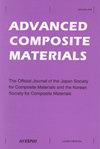氧化铋(III)修饰氧化石墨烯填充环氧纳米复合材料:热力学和光子衰减性能
IF 2.3
3区 材料科学
Q3 MATERIALS SCIENCE, COMPOSITES
引用次数: 2
摘要
在这项研究中,铋(III)氧化物(Bi2O3)修饰氧化石墨烯(GO)纳米复合材料被用作环氧基的新型辐射防护填料。用Bi2O3修饰氧化石墨烯使其转变为Bi2O3颗粒的载体,从而通过填料的有效分布提高环氧复合材料的热机械性能和辐射屏蔽性能。结构和成分研究证实了Bi2O3在氧化石墨烯表面的成功修饰。在此基础上,采用溶液铸造技术合成了含装饰填料的不同负载(5%、10%和15% wt%)的环氧复合材料。系统地考察了表面装饰与填料载荷之间的关系,以及复合材料的热力学、粘弹性和辐射屏蔽性能。这些纳米复合材料表现出良好的耐热性(~ 450℃)、高玻璃化转变温度(~ 136℃)、弹性模量(~ 4.36 GPa)和存储模量,从而证实了复合材料的分散性和界面粘附性的改善。在具有医学意义的大能量范围(30 - 1332 keV)内,环氧复合材料的x射线和γ射线屏蔽性能显著提高。这些低负载BGO/环氧复合材料的屏蔽效率与单独含有Bi2O3纳米颗粒的复合材料和高负载的微复合材料相当。本文章由计算机程序翻译,如有差异,请以英文原文为准。
Bismuth (III) oxide decorated graphene oxide filled epoxy nanocomposites: thermo-mechanical and photon attenuation properties
In this study, bismuth (III) oxide (Bi2O3) decorated graphene oxide (GO) nanocomposites were employed as novel radioprotective fillers in the epoxy matrix. Decoration of GO with Bi2O3 would transform it as carrier for Bi2O3 particles, thereby enhancing the thermo-mechanical and radiation shielding properties of the epoxy composites through effective filler distribution. Structural and compositional studies confirmed the successful decoration of Bi2O3 on the surface of GO. Thereupon, epoxy composites containing decorated fillers at different loadings (5, 10 and 15 wt%) were synthesized using solution casting technique. The correlation between surface decoration and filler loading was systematically examined as function of thermo-mechanical, viscoelastic and radiation shielding properties of the composites. These nanocomposites displayed good thermal resistance (~ 450 °C), high glass transition temperature (~ 136 °C), elastic modulus (~ 4.36 GPa) and storage modulus, thereby confirming the improved dispersion and better interfacial adhesion in the composites. The formation of continuous filler network across epoxy matrix formed by decorated fillers significantly improved X-ray and γ-ray shielding properties of epoxy composites in the wide energy range of medical interest (30 – 1332 keV). Shielding efficiency of these lowly loaded BGO/epoxy composites were comparable with the composites containing Bi2O3 nanoparticles alone and highly loaded microcomposites.
求助全文
通过发布文献求助,成功后即可免费获取论文全文。
去求助
来源期刊

Advanced Composite Materials
工程技术-材料科学:复合
CiteScore
5.00
自引率
20.70%
发文量
54
审稿时长
3 months
期刊介绍:
"Advanced Composite Materials (ACM), a bi-monthly publication of the Japan Society for Composite Materials and the Korean Society for Composite Materials, provides an international forum for researchers, manufacturers and designers who are working in the field of composite materials and their structures. Issues contain articles on all aspects of current scientific and technological progress in this interdisciplinary field. The topics of interest are physical, chemical, mechanical and other properties of advanced composites as well as their constituent materials; experimental and theoretical studies relating microscopic to macroscopic behavior; testing and evaluation with emphasis on environmental effects and reliability; novel techniques of fabricating various types of composites and of forming structural components utilizing these materials; design and analysis for specific applications.
Advanced Composite Materials publishes refereed original research papers, review papers, technical papers and short notes as well as some translated papers originally published in the Journal of the Japan Society for Composite Materials. Issues also contain news items such as information on new materials and their processing."
 求助内容:
求助内容: 应助结果提醒方式:
应助结果提醒方式:


